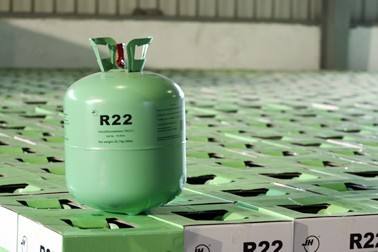What does the surge in refrigerant prices mean?
- Categories:Company news
- Author:
- Origin:
- Time of issue:2022-01-19
- Views:0
(Summary description)Refrigerant is one of the most shining stars in the industry this year.
On the one hand, its price soared all the way, rising stronger and stronger, leaving other products behind. On the other hand, China's acceptance of the Kigali amendment to the Montreal Protocol, the target of carbon peaking and carbon neutralization, and the implementation of "dual control of energy consumption" have brought new opportunities and challenges to refrigerants. As the end of the year approaches, we will review the development and trend of refrigerants.
What does the surge in refrigerant prices mean?
(Summary description)Refrigerant is one of the most shining stars in the industry this year.
On the one hand, its price soared all the way, rising stronger and stronger, leaving other products behind. On the other hand, China's acceptance of the Kigali amendment to the Montreal Protocol, the target of carbon peaking and carbon neutralization, and the implementation of "dual control of energy consumption" have brought new opportunities and challenges to refrigerants. As the end of the year approaches, we will review the development and trend of refrigerants.
- Categories:Company news
- Author:
- Origin:
- Time of issue:2022-01-19
- Views:0
The refrigerant is on the air outlet. Has the industry reached an inflection point?
At present, the prices of refrigerant products including the second-generation refrigerants R22 and R142b and the third-generation refrigerants R134a, R32 and R410A have increased significantly.
On the one hand, it is caused by the supply of raw materials. The starting point of refrigerants is fluorite. In recent years, China's exploitation of fluorite has even been unable to meet the demand for self-use, and the import of fluorite has correspondingly increased rapidly. By last year, China's self-sufficiency rate of fluorite had fallen below 90% to 87.76%. Hydrofluoric acid is generated by the reaction of fluorite and sulfuric acid. It is the most important raw material of refrigerant. In 2020, the operating rate of hydrofluoric acid in China will further drop to 55%, resulting in the tightening of the upstream of fluorochemical industry.
On the other hand, the state's inspection of "dual control" of energy consumption has been relatively strict and gradually upgraded. Several provinces, including Jiangsu, Zhejiang, Shandong, Guangxi and Yunnan, began power rationing and shutdown. Under the influence of limited power and production, the operation of the refrigerant industry has decreased significantly. At present, the overall operation rate of the industry has been less than 40%.
At the same time, power and production restrictions also limit the production capacity of upstream raw material enterprises, resulting in a relative shortage of raw material supply, which further exacerbated the downturn in the operating rate of the refrigerant industry and exacerbated the tense supply situation of the industry.
The shortage of raw materials is an important reason for the rise in refrigerant prices, but the fundamental reason is the significant improvement in demand. The actual demand impacted by the epidemic will eventually return to normal. At the same time, the refrigeration demand in China and the world will also maintain a long-term upward trend. Due to quota constraints, the supply of second-generation refrigerants is limited, and the supply of third-generation refrigerants may be in short supply for a long time.
Based on this, many people in the industry judge that under the background of the gradual withdrawal of second-generation refrigerants, the popularity of fourth-generation refrigerants and the steady growth of downstream demand, the third-generation refrigerants are expected to open the "golden decade" of high prosperity in the future after the reversal.

What has the refrigerant experienced from the first generation to the fourth generation?
At present, there are four generations of refrigerants.
The first generation refrigerant: it has the greatest damage to the ozone layer and has been phased out all over the world. In the 1930s, fluorine-containing refrigerants began to be applied, marking the beginning of organic fluorine chemical industry. In 1977, the British scientific research team found the ozone layer hole over Antarctica, and then found that CFCs refrigerant was one of the main reasons for destroying the ozone layer, which aroused widespread concern of the international community.
Second generation refrigerant: the most representative is R22, which is widely used in air conditioning, refrigeration, foaming and other industries. The second generation refrigerant has little damage to the ozone layer and has been eliminated in European and American countries. It is widely used in China, especially in the maintenance and after-sales market. At present, it is in the elimination period.
Third generation refrigerants: represented by R32, R134a, R125 and R410A, the ODP of refrigerants is zero and has no damage to the ozone layer, but the GWP value is high. At present, it is in the early stage of phase out. It is expected that the global consumption of third generation refrigerants will decrease by about 85% by 2050.
The fourth generation refrigerant: refers to the refrigerant with zero ODP and very low GWP. At present, the world's leading enterprises focus on it, which is not only the market leader and the trend of environmental protection, but also the master of the right to speak.
Global refrigerant upgrading and replacement is imminent
In the history of the development and elimination of refrigerants, countries and organizations have issued a large number of agreements, regulations and policies, among which the Montreal Protocol has the most cross era significance.
In 1987, in view of the direct and close link between Freon emissions and the disappearance of the ozone layer, representatives of 26 countries signed the Montreal Protocol in Montreal, Canada.
In 1989, the protocol came into force, and about 197 countries signed and adopted it. The ozone layer over Antarctica finally entered a long recovery period.
According to the Montreal agreement, the second generation refrigerant will be completely phased out. At present, developed countries have been completely eliminated in 2020; Developing countries will also be completely phased out by 2030.
According to the phase out requirements of the Montreal Protocol, China needs to reduce ODS HCFCs to 65% and 32.5% of the baseline level in 2020 and 2025, and achieve total phase out by 2030. In 2020, the quota of fluorine refrigerant R22 was 224800 tons, a decrease of 42200 tons compared with 2019 (year-on-year - 15.8%).
The Kigali amendment to the Montreal protocol is an amendment bill aimed at controlling the greenhouse gases of hydrofluorocarbons (HFCS) officially reached by the 28th Conference of the parties to the Montreal Protocol held in Kigali, capital of Rwanda, in October 2016.
By 2017, the important amendment to the Montreal Protocol has crossed the approval threshold, marking the gradual reduction of the use of climate affecting third-generation refrigerant hydrofluorocarbons (HFCS) from January 1, 2019. The amendment requires that global HFCS consumption will fall by about 85% by 2050.
This is a milestone in the refrigerant phase out process and also releases a huge political signal that the international community is determined to phase out the use of HFCS.
In December 2019, the European Commission officially issued the European Green agreement, which proposed that the EU would achieve zero net greenhouse gas emissions by 2050 and decouple economic growth from resource consumption.
In April 2021, US President Biden held a global climate summit and promised that the US government's emission reduction target is to reduce US greenhouse gas emissions by 50% - 52% compared with 2005 by 2030 and achieve net zero emissions by 2050. The first step in the EPA's proposal to phase out HFCS is to reduce the supply of HFCS by 85% over the next 15 years.
*** ***
At the same time, China announced that it would strive to achieve carbon peak by 2030 and carbon neutralization by 2060, and integrate it into the overall layout of ecological civilization construction.
Then, India announced that from 2032, India will gradually reduce HFCS in four steps, with cumulative reductions of 10% in 2032, 20% in 2037, 30% in 2042 and 80% in 2047. With rapid economic growth, India, together with China and the United States, is regarded as one of the countries with the highest current and potential HFC emissions in the world.
China accepts the Kigali amendment and HFCs control is implemented
At present, China's refrigerant market is in the replacement period of the third generation to the second generation refrigerant products
In October 2016, the Kigali amendment included 18 HFCS in the list of controlled substances, aiming to gradually reduce climate warming in the coming decades. The State Party is required to destroy hydrofluorocarbons with technology approved by the party from 1 January 2020. On September 15, the Kigali amendment to the Montreal Protocol (hereinafter referred to as the Kigali Amendment) officially entered into force in China.
According to insiders, HFCs is a substitute for chlorofluorocarbons (CFCs) which destroys the ozone layer. It belongs to the three generation of refrigerants, and is widely used in refrigerators and air-conditioning refrigerants and insulation foam production. Although HFCS do not contain chlorine or bromine atoms that destroy the earth's ozone layer, they are also a greenhouse gas with great impact. If the corresponding trend is not controlled, HFCS will produce 350 million to 880 million tons of carbon dioxide emissions by 2050, equivalent to the total greenhouse gas emissions from traffic on earth.
On June 17, 2021, the permanent mission of China to the United Nations deposited with the Secretary General of the United Nations the letter of acceptance of the Chinese government's acceptance of the Kigali amendment to the Montreal Protocol on substances that Deplete the ozone layer, which entered into force for China on September 15, 2021.
On September 30, 2021, China's Ministry of ecology and environment issued the notice on strictly controlling the first batch of hydrofluorocarbon chemical production and construction projects (Exposure Draft), which requires that all localities shall not build or expand R32, R134a, R125, r143a and R245fa chemical production facilities for controlled purposes such as refrigerant and foaming agent.
This means that China's control policies for HFCS refrigerants have been gradually implemented, and the production and consumption of HFCS refrigerants will be gradually reduced. The application of a new generation of HfO refrigerants with high performance and low GWP (global warming potential) will become the main development direction of China's refrigeration industry.
The refrigerant has entered the era of low GWP value, and the flammability problem can not be ignored
There is no doubt that the Kigali amendment has promoted the iterative renewal of refrigerant products.
Looking at the first to fourth generation refrigerants, it is rare to meet all the requirements of future refrigerants for low GWP value, safety, thermodynamic performance and environmental performance at the same time.
In other words, many low GWP values are combustible!
The national standard "numbering method and safety classification of refrigerants" (GB / T 7778-2017) divides the toxicity of refrigerants into class A (low chronic toxicity) and class B (high chronic toxicity), and divides the flammability into class 1 (no flame propagation), class 2L (weak possibility), class 2 (possibility) and class 3 (combustible and explosive). According to GB / T 7778-2017, refrigerant safety is divided into 8 categories: A1, A2L, A2, A3, B1, B2L, B2 and B3, among which A1 is the safest and B3 is the most dangerous.
Generally speaking, household air conditioners, central air conditioners and other refrigeration equipment have been tested at the factory, indicating the reference value of refrigerant charge.
However, many large central air-conditioning units and industrial chillers need to be filled with refrigerant on site, as do household air conditioners, refrigerator equipment, cold storage, etc.
Moreover, the refrigerant charge of some equipment is different due to different types of evaporators. In addition, at the maintenance and installation site, due to limited conditions, many maintenance workers charge refrigerant based on experience.
Based on this, some leading refrigerant enterprises have launched weakly combustible low GWP refrigerants and are committed to promoting system design and popular science training to solve flammability risks.
Scan the QR code to read on your phone
Contact mode
Mobile phone:13501730862
Telephone:021-58996252
Address:No. 165, Jingya Road, Pudong New Area, Shanghai
© 2021 Shanghai Shangling Technology Development Co., Ltd All rights reserved. 京ICP證000000号 Technical support: China Enterprise Power Shanghai SEO






